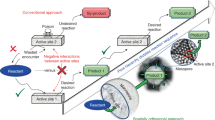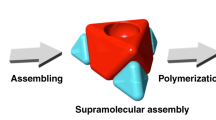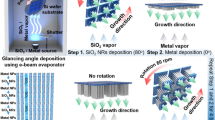Abstract
The chemical functionality within porous architectures dictates their performance as heterogeneous catalysts1; however, synthetic routes to control the spatial distribution of individual functions within porous solids are limited. Here we report the fabrication of spatially orthogonal bifunctional porous catalysts, through the stepwise template removal and chemical functionalization of an interconnected silica framework. Selective removal of polystyrene nanosphere templates from a lyotropic liquid crystal-templated silica sol–gel matrix, followed by extraction of the liquid crystal template, affords a hierarchical macroporous–mesoporous architecture. Decoupling of the individual template extractions allows independent functionalization of macropore and mesopore networks on the basis of chemical and/or size specificity. Spatial compartmentalization of, and directed molecular transport between, chemical functionalities affords control over the reaction sequence in catalytic cascades2,3; herein illustrated by the Pd/Pt-catalysed oxidation of cinnamyl alcohol to cinnamic acid. We anticipate that our methodology will prompt further design of multifunctional materials4,5,6 comprising spatially compartmentalized functions.
This is a preview of subscription content, access via your institution
Access options
Subscribe to this journal
Receive 12 print issues and online access
$259.00 per year
only $21.58 per issue
Buy this article
- Purchase on Springer Link
- Instant access to full article PDF
Prices may be subject to local taxes which are calculated during checkout



Similar content being viewed by others
References
Parlett, C. M. A., Wilson, K. & Lee, A. F. Hierarchical porous materials: Catalytic applications. Chem. Soc. Rev. 42, 3876–3893 (2013).
Climent, M. J., Corma, A., Iborra, S. & Sabater, M. J. Heterogeneous catalysis for tandem reactions. ACS Catal. 4, 870–891 (2014).
Merino, E. et al. Synthesis of structured porous polymers with acid and basic sites and their catalytic application in cascade-type reactions. Chem. Mater. 25, 981–988 (2013).
Balazs, A. C., Emrick, T. & Russell, T. P. Nanoparticle polymer composites: Where two small worlds meet. Science 314, 1107–1110 (2006).
Cheong, S. W. & Mostovoy, M. Multiferroics: A magnetic twist for ferroelectricity. Nature Mater. 6, 13–20 (2007).
Kim, J., Piao, Y. & Hyeon, T. Multifunctional nanostructured materials for multimodal imaging, and simultaneous imaging and therapy. Chem. Soc. Rev. 38, 372–390 (2009).
Maeda, K. et al. Photocatalyst releasing hydrogen from water. Nature 440, 295 (2006).
Ragesh, P., Ganesh, V. A., Nair, S. V. & Nair, A. S. A review on ‘self-cleaning and multifunctional materials’. J. Mater. Chem. A 2, 14773–14797 (2014).
Lu, W. & Lieber, C. M. Nanoelectronics from the bottom up. Nature Mater. 6, 841–850 (2007).
Zhou, W., Ding, L., Yang, S. & Liu, J. Orthogonal orientation control of carbon nanotube growth. J. Am. Chem. Soc. 132, 336–341 (2010).
Paciello, A. & Santonicola, M. G. A supramolecular two-photon-active hydrogel platform for direct bioconjugation under near-infrared radiation. J. Mater. Chem. B 3, 1313–1320 (2015).
Chen, A. Y. et al. Synthesis and patterning of tunable multiscale materials with engineered cells. Nature Mater. 13, 515–523 (2014).
Grunes, J., Zhu, J., Anderson, E. A. & Somorjai, G. A. Ethylene hydrogenation over platinum nanoparticle array model catalysts fabricated by electron beam lithography: Determination of active metal surface area. J. Phys. Chem. B 106, 11463–11468 (2002).
Yamada, Y. et al. Nanocrystal bilayer for tandem catalysis. Nature Chem. 3, 372–376 (2011).
Dhainaut, J., Dacquin, J.-P., Lee, A. F. & Wilson, K. Hierarchical macroporous-mesoporous SBA-15 sulfonic acid catalysts for biodiesel synthesis. Green Chem. 12, 296–303 (2010).
Wainwright, S. G. et al. True liquid crystal templating of SBA-15 with reduced microporosity. Micropor. Mesopor. Mater. 172, 112–117 (2013).
Zhao, D. Y. et al. Triblock copolymer syntheses of mesoporous silica with periodic 50 to 300 angstrom pores. Science 279, 548–552 (1998).
Mazumder, V. & Sun, S. Oleylamine-mediated synthesis of Pd nanoparticles for catalytic formic acid oxidation. J. Am. Chem. Soc. 131, 4588–4589 (2009).
Nicolaou, K. C., Edmonds, D. J. & Bulger, P. G. Cascade reactions in total synthesis. Angew. Chem. Int. Ed. 45, 7134–7186 (2006).
Motokura, K., Tada, M. & Iwasawa, Y. Heterogeneous organic base-catalyzed reactions enhanced by acid supports. J. Am. Chem. Soc. 129, 9540–9541 (2007).
Burt, S. Essential oils: Their antibacterial properties and potential applications in foods—A review. Int. J. Food Microbiol. 94, 223–253 (2004).
Soto-Vaca, A., Gutierrez, A., Losso, J. N., Xu, Z. & Finley, J. W. Evolution of phenolic compounds from color and flavor problems to health benefits. J. Agric. Food Chem. 60, 6658–6677 (2012).
Hackett, S. F. J. et al. High-activity, single-site mesoporous Pd/Al2O3 catalysts for selective aerobic oxidation of allylic alcohols. Angew. Chem. Int. Ed. 119, 8747–8750 (2007).
Lee, A. F. et al. Reaction-driven surface restructuring and selectivity control in allylic alcohol catalytic aerobic oxidation over Pd. J. Am. Chem. Soc. 133, 5724–5727 (2011).
Durndell, L. J. et al. Selectivity control in Pt-catalyzed cinnamaldehyde hydrogenation. Sci. Rep. 5, 9425 (2015).
Durndell, L. J., Parlett, C. M. A., Hondow, N. S., Wilson, K. & Lee, A. F. Tunable Pt nanocatalysts for the aerobic selox of cinnamyl alcohol. Nanoscale 5, 5412–5419 (2013).
Zhang, F., Jiang, H., Li, X., Wu, X. & Li, H. Amine-functionalized GO as an active and reusable acid–base bifunctional catalyst for one-pot cascade reactions. ACS Catal. 4, 394–401 (2014).
Zeidan, R. K., Hwang, S.-J. & Davis, M. E. Multifunctional heterogeneous catalysts: SBA-15-containing primary amines and sulfonic acids. Angew. Chem. Int. Ed. 45, 6332–6335 (2006).
Dacquin, J.-P. et al. An efficient route to highly organized, tunable macroporous-mesoporous alumina. J. Am. Chem. Soc. 131, 12896–12897 (2009).
Sen, T., Tiddy, G. J. T., Casci, J. L. & Anderson, M. W. Synthesis and characterization of hierarchically ordered porous silica materials. Chem. Mater. 16, 2044–2054 (2004).
Acknowledgements
This work was supported by the EPSRC (EP/G007594/4). A.F.L. was supported by an EPSRC Leadership Fellowship, K.W. by a Royal Society Industry Fellowship, and S.K.B. by a Durham University Addison Wheeler Fellowship and The Leverhulme Trust ECF schemes. L.M.B. acknowledges the EPSRC for a studentship. Electron microscopy access was provided through the Leeds EPSRC Nanoscience and Nanotechnology Research Equipment Facility (LENNF) (EP/K023853/1), the University of Birmingham Nanoscale Physics Laboratory, and DU GJ Russell Microscopy Facility.
Author information
Authors and Affiliations
Contributions
A.F.L., C.M.A.P. and K.W. planned the experiments. C.M.A.P. synthesized all porous materials and performed catalytic testing. L.M.B. and S.K.B. synthesized and characterized the Pd colloids. C.M.A.P., M.A.I. and N.S.H. undertook materials characterization. A.F.L. wrote the manuscript.
Corresponding author
Ethics declarations
Competing interests
The authors declare no competing financial interests.
Supplementary information
Supplementary Information
Supplementary Information (PDF 2621 kb)
Rights and permissions
About this article
Cite this article
Parlett, C., Isaacs, M., Beaumont, S. et al. Spatially orthogonal chemical functionalization of a hierarchical pore network for catalytic cascade reactions. Nature Mater 15, 178–182 (2016). https://doi.org/10.1038/nmat4478
Received:
Accepted:
Published:
Issue Date:
DOI: https://doi.org/10.1038/nmat4478
This article is cited by
-
Selective hydrodeoxygenation of α, β-unsaturated carbonyl compounds to alkenes
Nature Communications (2024)
-
Nanoparticle proximity controls selectivity in benzaldehyde hydrogenation
Nature Catalysis (2024)
-
Emulsion-oriented assembly for Janus double-spherical mesoporous nanoparticles as biological logic gates
Nature Chemistry (2023)
-
Tandem catalysis with double-shelled hollow spheres
Nature Materials (2022)
-
Electrostatically cooperative host-in-host of metal cluster ⊂ ionic organic cages in nanopores for enhanced catalysis
Nature Communications (2022)



